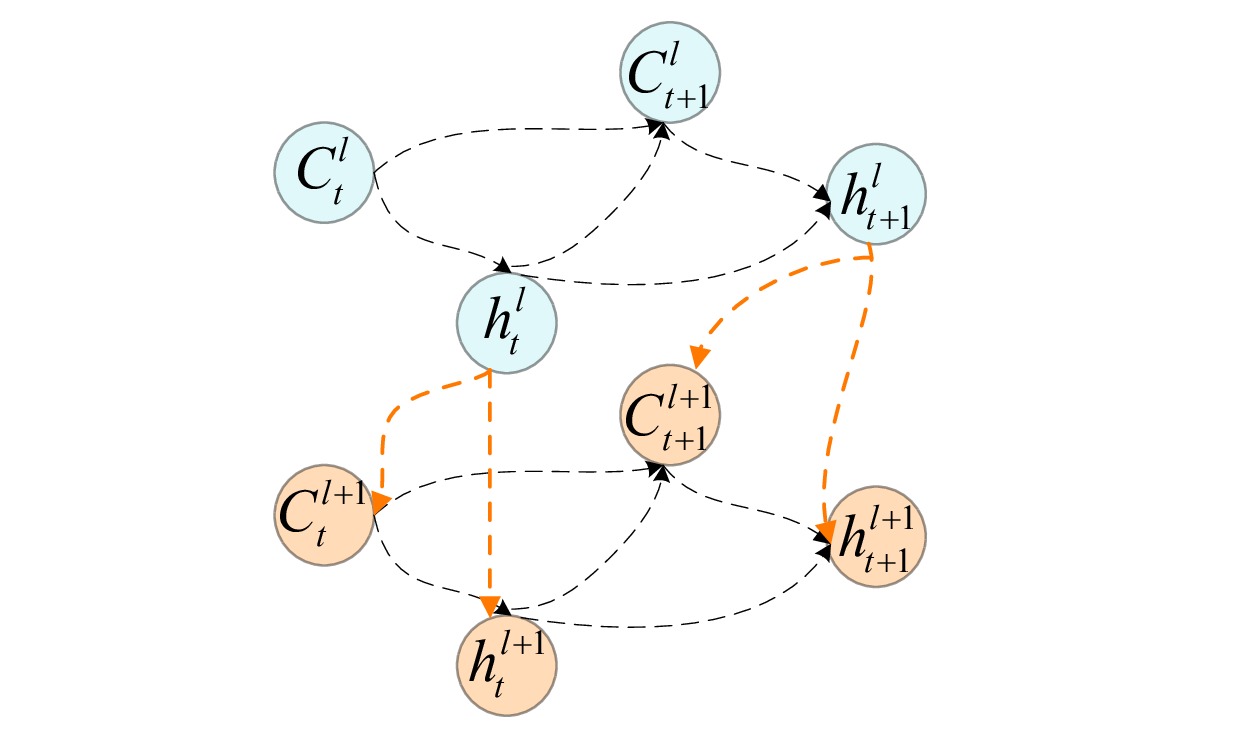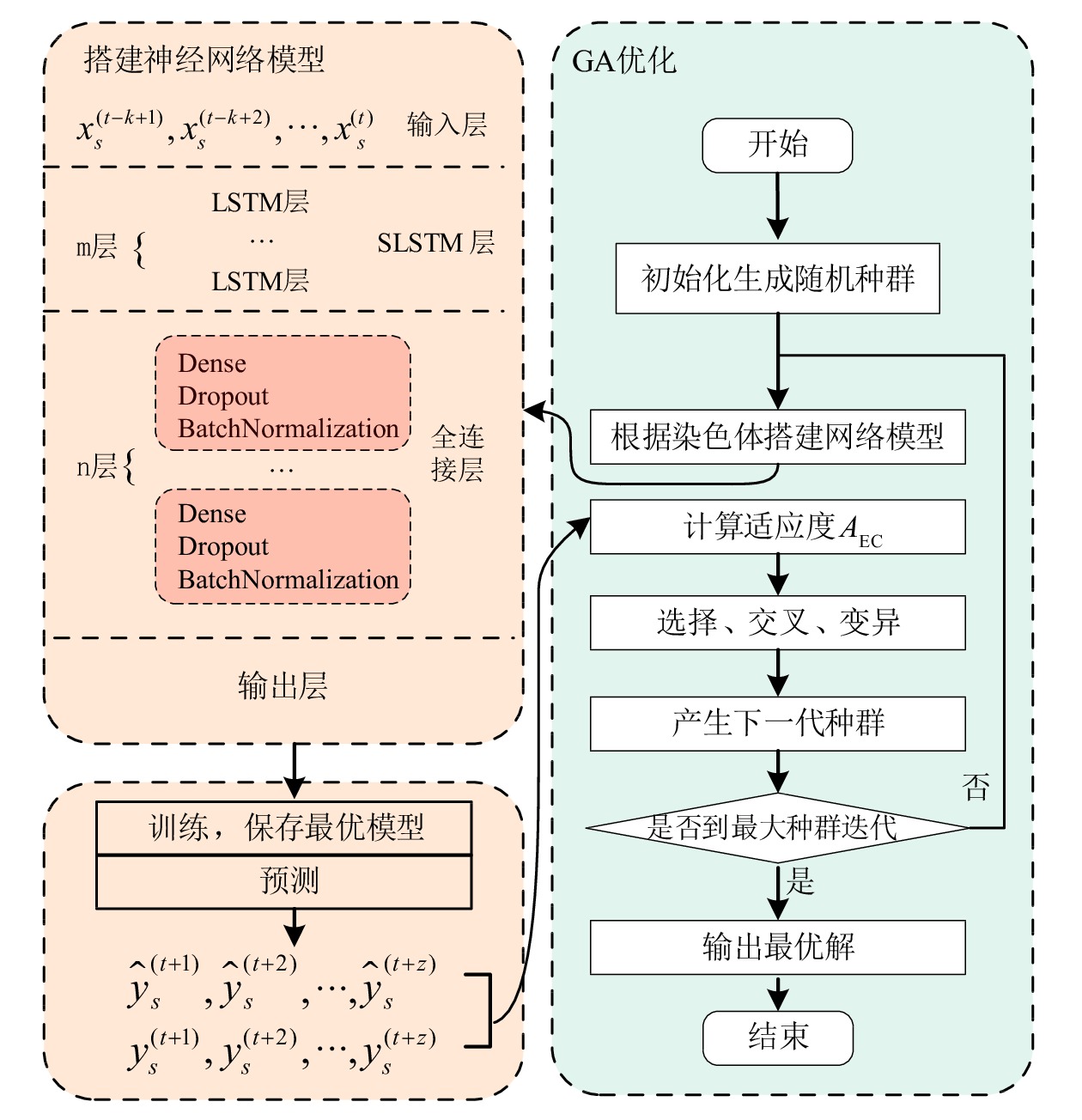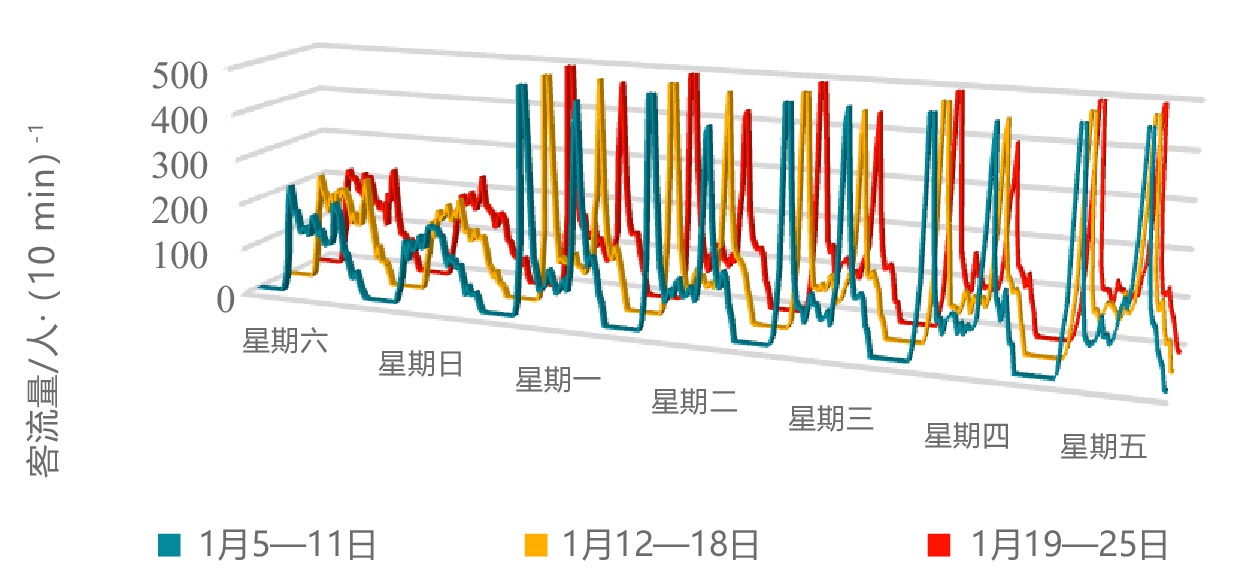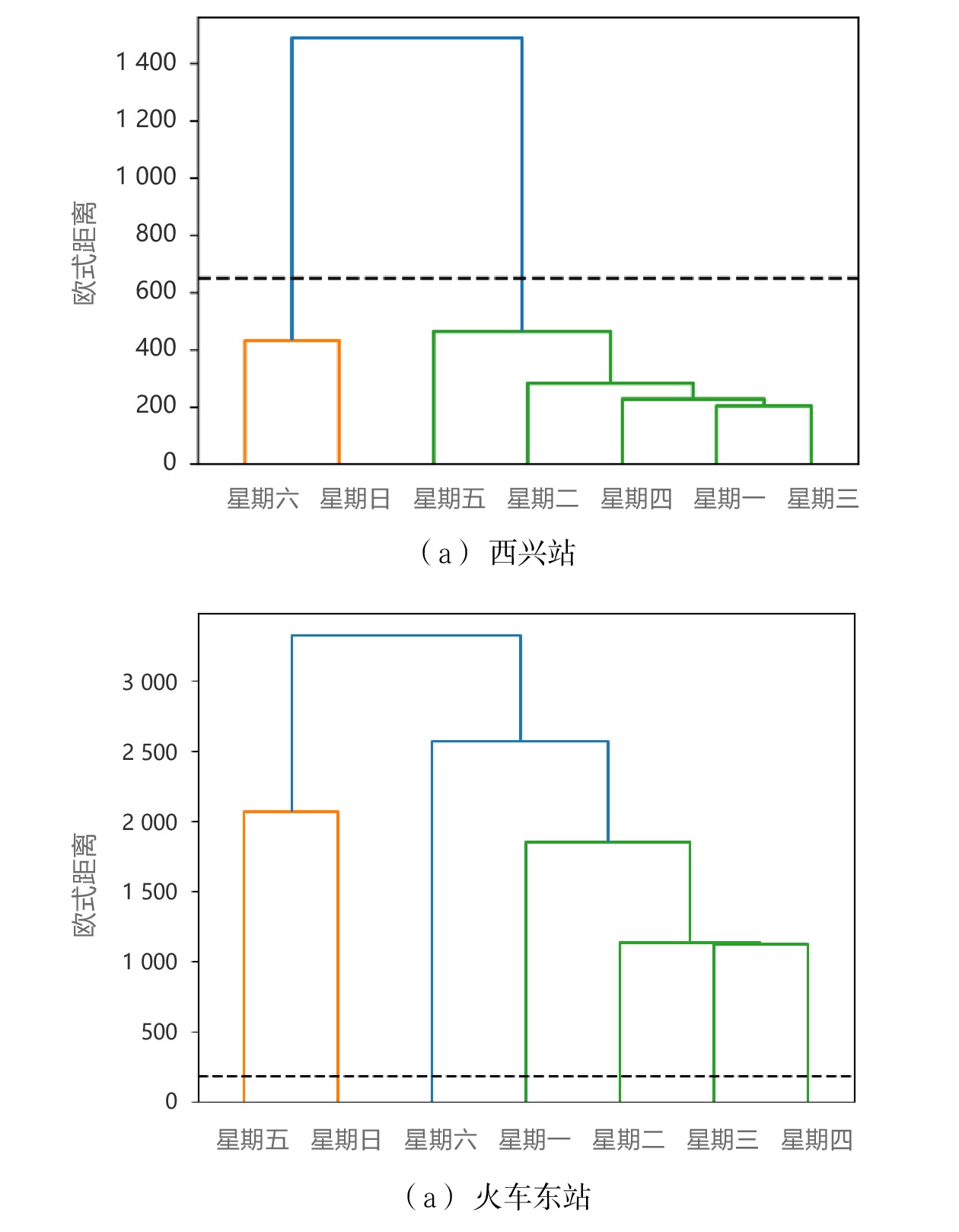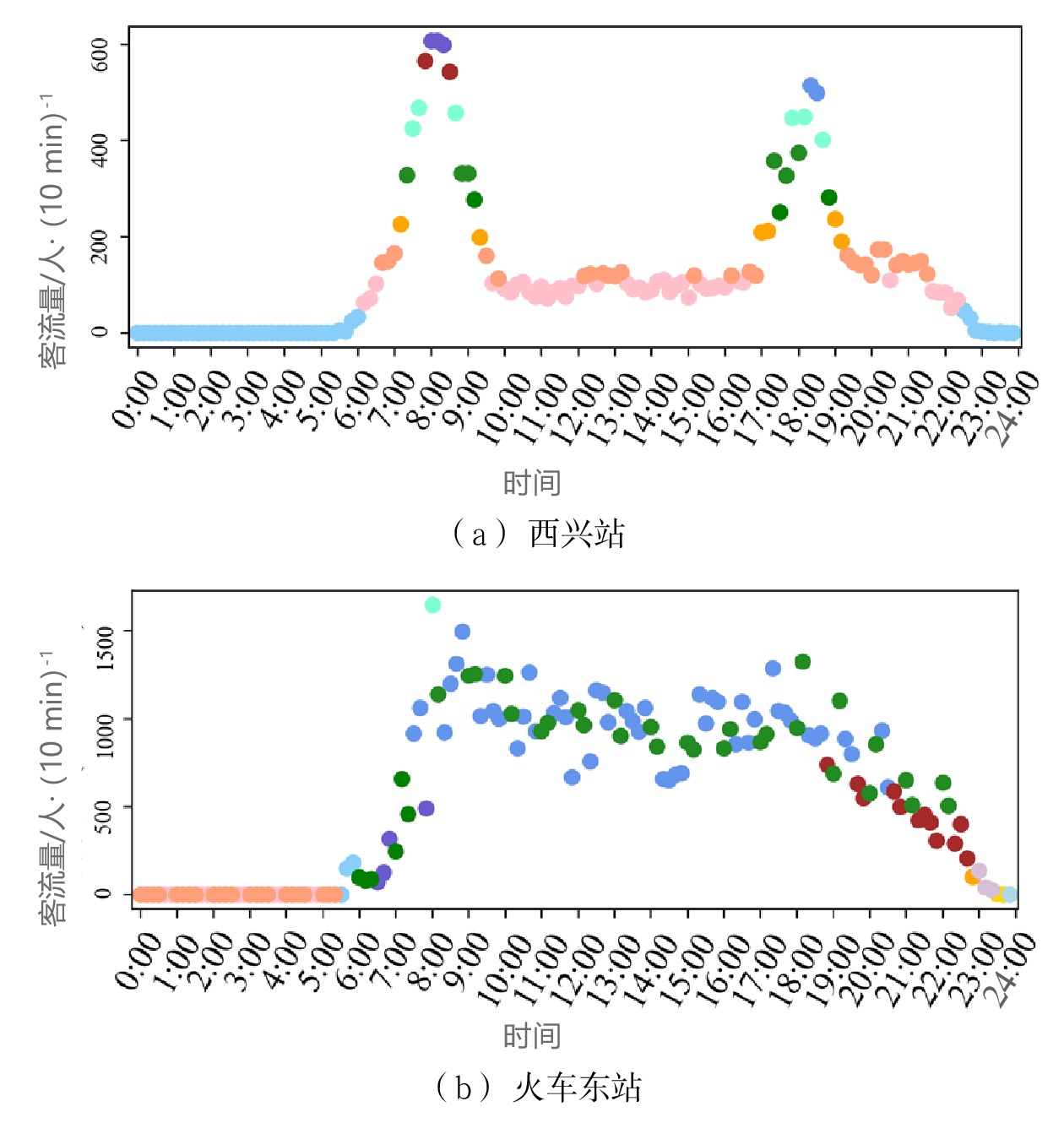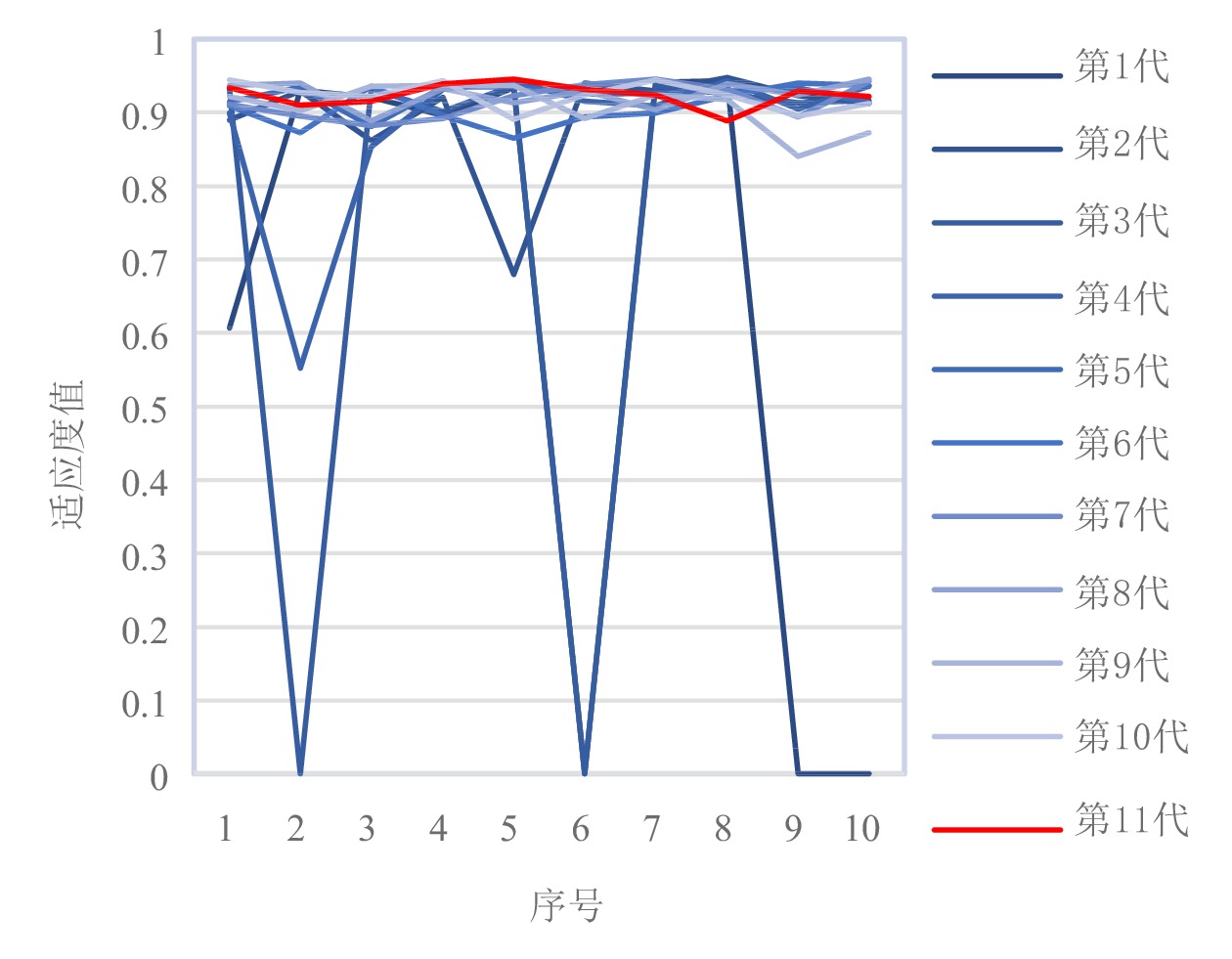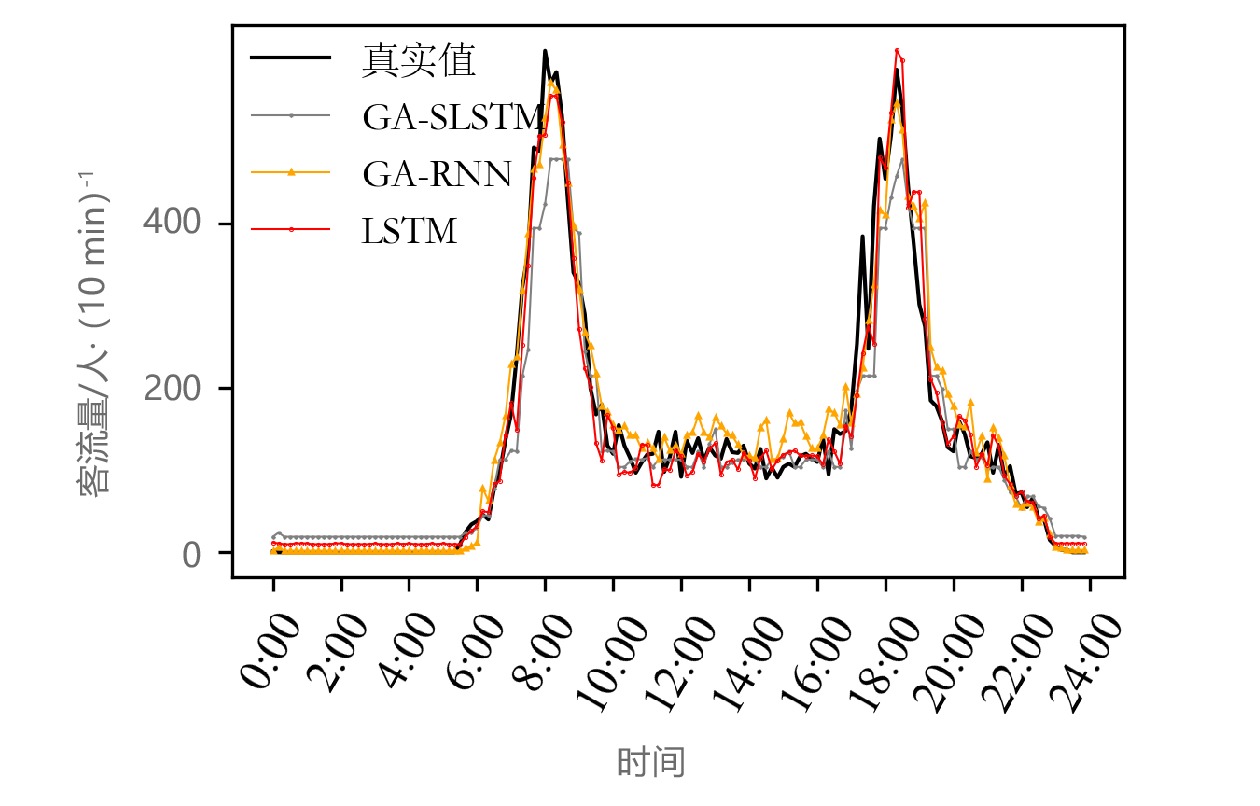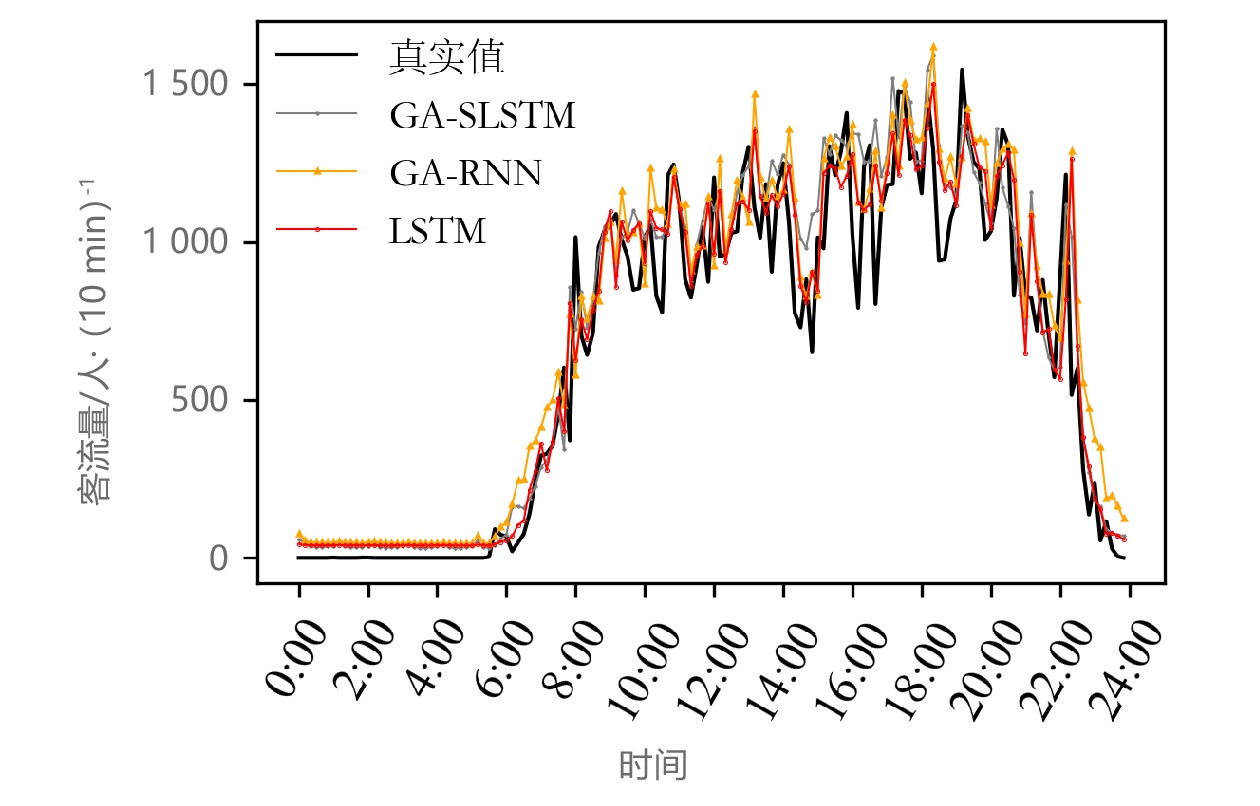Short-term passenger flow prediction of urban rail transit based on optimized GA-SLSTM
-
摘要: 城市轨道交通短时客流预测可为相关运营部门实时调整行车调度、提高运营效率提供重要的决策依据,为乘客提供合理出行建议。因此,针对具有非线性和随机性等特性的地铁进出站短时客流预测问题,文章在堆叠式长短时记忆(SLSTM,Stacked Long Short Term Memory)模型的基础上,引入遗传算法(GA,Genetic Algorithm),构建了GA-SLSTM预测模型。以10 min为预测粒度对地铁历史运营数据进行整理,分析了客流变化特征,并将其与GA-循环神经网络(RNN ,Recurrent Neural Network)模型和LSTM模型的预测效果进行对比。GA-SLSTM预测模型对普通站点和换乘站点预测值的决定系数R2的平均值分别达到0.95和0.90,预测值对真实值的拟合效果较好,预测误差低于其他2种模型,证明该方法可提高地铁短时客流预测的准确性。
-
关键词:
- 城市轨道交通 /
- 短时客流预测 /
- 堆叠式长短时记忆(SLSTM)模型 /
- 智能交通 /
- 遗传算法
Abstract: Short-term passenger flow prediction of urban rail transit can provide important decision-making basis for relevant operation departments to adjust traffic scheduling in real time and improve operation efficiency, and provide reasonable travel suggestions for passengers. Therefore, aiming at the prediction of short-term passenger flow in and out of subway stations with nonlinear and random characteristics, this paper introduced Genetic Algorithm (GA) on the basis of Stacked Long Short Term Memory (SLSTM) network, and constructed a GA-SLSTM prediction model. The paper sorted out the historical operation data of the subway granularity of 10 minutes, analyzed the characteristics of passenger flow changes, and compared their prediction effects with GA-RNN and LSTM network models. The average value of the decision coefficient R2 of GA-SLSTM method for the predicted values of ordinary stations and transfer stations reached 0.95 and 0.90 respectively. The predicted value has a good fitting effect on the real value, and the prediction error is lower than the other two models, which proves that this method can improve the accuracy of short-term passenger flow prediction of subway. -
可达性由汉森于1959年提出,定义交通网络中各节点相互作用机会的大小[1],可达性被广泛应用于城市规划、交通工程、地理信息系统等领域。空间句法理论产生于20世纪70年代末,由Bill Hillier提出[2],运用空间句法对城市轨道交通线网进行分析研究,定量分析城市轨道交通线网节点可达性和拓扑性,对轨道交通线网规划和预测城市的空间发展格局具有一定的参考价值,使城市充分发挥其空间效益。张义汉等人[3]以加权平均旅行时间为指标分析了广州地铁网络的可达性;吴一州等人[4]通过空间句法模型分析杭州1号线空间整合度,研究轨道交通供需特征;陈明星等人[5]基于空间句法模型,引入通达能力和集成程度,进行城市轨道交通网络特征的定量化研究;刘韶曼[1]基于空间句法对郑州市近远期轨道交通规划线网可达性进行了研究。目前的研究主要集中于某一线路或路网的可达性,对城市不同建设规划时期轨道交通线网的可达性研究较少,本文基于空间句法,定量分析不同建设规划时期深圳市城市轨道交通线网的可达性,预测城市未来发展格局,可为进一步优化轨道交通线网提供参考。
1 可达性评价体系构建
1.1 空间句法
空间句法的基本原则是将空间系统划分为各组成单元,并将空间系统转化为节点及其相互连接构成的连接图[6],既反映局部的空间可达性,同时强调整体的空间通达性和关联性。轴线法是空间句法常用的一种分割方法,基本原则是用最少数目的最长直线绘制轴线图[7],如图1所示。每条轴线代表一个相对独立的子空间,当轴线与轴线有交叉,轴线为直接相连关系,如图1(a)所示;由轴线代表的节点连接关系可简化为图1(b);利用轴线图可计算各条轴线句法变量值[8],用暖色到冷色不同颜色表示各轴线句法变量的大小,从而分析研究空间系统组成及空间形态,如图1(c)所示。轴线法也是分析城市空间系统常用的方法,可通过城市空间内部相对连续的轴线结构对城市轨道交通空间结构进行定量分析,探讨城市空间发展趋势。
1.2 空间句法变量
根据轴线图中节点之间的连接关系,可得出基于拓扑关系计算的句法变量[9],定量分析空间形态发展规律及趋势。空间句法的基本变量有连接值、平均深度值、整合度等。
(1)连接值
连接值表示系统空间中与第i个单元空间相交的空间个数,连接值越高,表示其空间渗透性越好。在轨道交通线网中表示为第i个站点与其他站点直接相连的个数,例如,图1(b)中节点4的连接值为5。
Ci=k (1) 式中:
Ci 为节点i的连接值;k为与节点i连接的节点数。
(2)平均深度值
假定两个相邻节点间为一步,则节点i到另一节点的最少步数即为这两个节点间的深度,表示空间系统的拓扑结构节点间转换次数。在轨道交通线网中,表示站点i到另一站点所经过的最少站点数。
Di=k∑di=1di⋅Ni (2) 式中:
Di 为节点i的深度值;Ni 为节点i的最少步数的节点个数;di 为节点i到另一节点的最少步数。1 ≤ k ≤ n ; n<空间系统节点总数。当
k =1时,Di 等于节点i的连接值;当k <n时,Di 为节点i的局部深度值;当k =n时,Di 为节点i的全局深度值。实际应用中,多采取平均深度值,节点 i 的平均深度值是节点i到其他所有节点的最少步数的平均值。在轨道交通线网中,表示从一个站点平均经过几个站点可以到达另一站点。
MDi=k∑di=1di⋅Nim−1 (3) 式中:
MDi 为节点i的平均深度值;m为空间系统节点总数,m>1。
(3)整合度
整合度与平均深度值成反比,表征空间系统中某一节点与其他节点间的聚集或离散程度。
Ii=m[log2(m+23−1)+1](m−1)(MDi−1) (4) 式中:
Ii 为节点i的整合度。1.3 可达性评价指标
整合度反映整体空间或局部空间的关系,即全局整合度和局部整合度,整合度越高则可达性越高。连接值与全局整合度相关关系决定了可理解度,全局整合度与局部整合度相关关系决定了空间智能度,可理解度和空间智能度反映了空间的分布规律及结构合理性。因此,选用全局整合度、局部整合度、可理解度和空间智能度作为可达性评价指标,构建可达性评价体系。
(1)全局整合度
全局整合度以整个空间系统为角度,用以表示节点与整个空间结构其他所有节点联系的紧密程度和到达其他节点的难易程度,反映节点在空间系统中的可达性。
(2)局部整合度
局部整合度是指某节点与其附近几步内可达节点联系的紧密程度,是以局部空间范围为角度,反映出在几步范围内到达节点的难易程度,是衡量可达性的重要指标[10]。例如,当选取
di =3且n>3时,则称为“3步整合度”。(3)可理解度
可理解度是空间系统连接值与全局整合度的相关关系,其值是局部参数与整体参数线性回归方程的回归系数。可理解度越高,则表示局部空间与整体空间的相似度越高,局部与整体越协调统一。
R2=[m∑i=1(Ci−ˉC)(Ii−ˉI)]2m∑i=1(Ci−ˉC)2m∑i=1(Ii−ˉI)2 (5) 式中:
R2 为可理解度;ˉC 为连接值的均值,ˉC=1mm∑i=1Ci ;Ii 为节点i的全局整合度;ˉI 为全局整合度的均值,ˉI=1mm∑i=1Ii 。(4)空间智能度
空间智能度是局部空间与整体空间之间的相互关系[10]。空间智能度反映了通过局部范围的空间连通性得到整体空间信息的程度,空间智能度越高,则局部空间与整体空间的相似度越高。
r2=[m∑i=1(I′i−ˉI′)(Ii−ˉI)]2m∑i=1(I′i−ˉI′)2m∑i=1(Ii−ˉI)2 (6) 式中:
r2 为空间智能度;I′i 为节点i的局部整合度;ˉI′ 为局部整合度的均值,ˉI′=1mm∑i=1I′i 。2 深圳市轨道交通可达性评价
2.1 深圳市轨道交通规划
轨道交通作为支撑深圳市“极点带动、轴带支撑”网络空间布局[11]、强化都市协调联动的重要基础设施,在区域综合交通中处于骨干地位。
深圳市城市轨道交通第3期建设规划周期为2011—2020年,12条线路运营,线路长度约438 km;根据文献[12]和文献[13],第4期建设规划周期完成后,将形成18条线路运营的城市轨道交通线网,线路长度共计约664 km;结合深圳市近期城际铁路建设规划,至2025年,深圳市将形成21条线路运营的城市轨道交通线网,线路长度共计约869 km。
2.2 可达性评价
以深圳市城市轨道交通网络为例,根据深圳市城市轨道交通第3期建设规划、第4期建设规划及近期城际铁路建设规划,利用AutoCAD绘制轨道交通线网,将其转化为dxf格式,导入到Depthmap空间句法分析软件,利用Convert功能将轨道交通线网数据进行Axial转换,构建空间句法轴线图,如图2(a)所示。运行Run Graph Analysis功能,将
di 设置为n,3,5,7,9,11,如图2(b)所示,表示以di 为步数进行句法变量计算,分别得到全局整合度、3步整合度、5步整合度、7步整合度、9步整合度、11步整合度。根据可达性指标和轴线图,对轨道交通可达性进行评价分析,最后得出空间句法在轨道交通线网规划中的应用结论。(1)全局整合度
深圳市城市轨道交通第3期建设规划线网、第4期建设规划线网及近期城际铁路建设规划线网的全局整合度计算结果如表1、图3~图5所示。图中,由暖色到冷色代表全局整合度的值由大到小,红色表示最大值,蓝色表示最小值。
表 1 全局整合度全局整合度 规划建设周期 第3期建设规划 第4期建设规划 近期城际铁路建设规划 最大值 0.752453 0.771542 1.101068 最小值 0.223049 0.238773 0.246861 平均值 0.509283 0.507727 0.672010 一般认为,整合度大于1时,空间聚集性较强,整合度介于0.4~0.6,则空间分布较为分散[14]。上述3个建设规划时期线网空间聚集性均较强,其中,第3期和第4期建设规划线网的整合度呈现出中心聚集,四周发散的形状特征,第3期与第4期建设规划线网相比,全局整合度变化不大;近期城际铁路的修建将大幅度提升线网的全局整合度,连接都市核心城区和城市组团的整合度得到提升,城市边缘的可达性得到进一步提升,将构建多中心、网络化、组团式市域空间格局。
(2)局部整合度
3个不同时期建设规划线网的局部整合度计算结果如表2所示。其中,3步整合度示意图如图6~图8所示。
表 2 局部整合度局部整合 度 规划建设周期 第3期建设规划 第4期建设规划 近期城际铁路建设规划 3步整合度 最大值 2.644112 2.881117 2.863038 最小值 0.333333 0.333333 0.333333 平均值 1.320318 1.400963 1.530065 5步整合度 最大值 1.757616 1.942911 1.929600 最小值 0.349023 0.349023 0.349023 平均值 1.018686 1.082745 1.187875 7步整合度 最大值 1.757616 1.536349 1.528753 最小值 0.328368 0.328368 0.328368 平均值 0.864999 0.916174 1.009850 9步整合度 最大值 1.168372 1.300960 1.279371 最小值 0.305556 0.305556 0.305556 平均值 0.764687 0.809191 0.895353 11步整合度 最大值 1.056157 1.120827 1.154161 最小值 0.284886 0.284886 0.284886 平均值 0.674251 0.729573 0.817141 随着轨道交通线网的完善,线网的3步整合度、5步整合度、7步整合度、9步整合度、11步整合度都得到提升,且近期城际铁路的修建将大幅度提升线网的局部整合度。第3期和第4期建设规划线网的局部整合度呈现出中心聚集、四周发散的特征,近期城际铁路建设规划线网局部的空间聚集性进一步增强,由中心城区的聚集向多区域、多中心、多组团的方向发展。
(3)可理解度
运用Depthmap空间句法分析软件中Scatter Plot工具,选取全局整合度和连接值进行相关性分析,3个不同时期建设规划线网的可理解度计算结果如表3、图9~图11所示。图中,横坐标轴为连接值,纵坐标轴为全局整合度。
表 3 可理解度可理解度 规划建设周期 第3期建设规划 第4期建设规划 近期城际铁路建设规划 R2 0.480758 0.399510 0.369836 3个不同时期轨道交通线网的可理解度均一般,表明通过连接值反映整体空间信息的程度均一般。随着线网的不断完善,可理解度不断下降;由于线网规模的不断扩大,城市由中心城区发展到外围多个组团区域,结构的不一致降低了整个线网的可理解度,局部与整体的相似性一般。
(4)空间智能度
利用Scatter Plot工具,选取全局整合度和3步整合度进行相关性分析,3个不同时期建设规划线网的空间智能度计算结果如表4、图12~图14所示。图中,横坐标轴为全局整合度,纵坐标轴为3步整合度。
表 4 空间智能度空间智能度 规划建设周期 第3期建设规划 第4期建设规划 近期城际铁路建设规划 r2 0.741433 0.588009 0.569742 3个不同时期轨道交通线网的空间智能度水平均较高,表明线网空间整体性较强,3步整合度较高程度地反映了整体空间信息。随着线网的不断完善,空间智能度不断下降,说明局部和整体的关联性在下降,表明深圳市仍处于高速发展时期,因城市规模增长迅速,使得城市形态结构在急剧变化,但城市轨道交通线网的空间智能度仍维持在较高水平。
3 结束语
基于空间句法,对深圳市城市轨道交通第3期建设规划、第4期建设规划及近期城际铁路建设规划线网进行可达性评价,城市呈现出由都市核心区向多区域、多中心、多组团方向发展的趋势,且都市核心区与组团间、区域组团之间空间结构存在较大差异,符合深圳市全域平衡发展,构建“多中心、网络化、组团式”空间格局的规划。空间句法能够定量描述轨道交通线网的可达性,预测城市未来发展格局,可为城市轨道交通线网规划提供一定的借鉴。今后将综合考虑乘客换乘时间、列车运行速度,旅客出行需求等因素,进一步完善城市轨道交通线网的可达性评价。
-
表 1 西兴站2个星期之间客流Spearman相关系数
星期一 星期二 星期三 星期四 星期五 星期六 星期日 上个星期一 0.976 0.968 0.975 0.971 0.955 0.778 0.623 上个星期二 0.979 0.972 0.976 0.975 0.952 0.759 0.596 上个星期三 0.970 0.972 0.973 0.965 0.955 0.784 0.631 上个星期四 0.961 0.974 0.970 0.963 0.957 0.776 0.628 上个星期五 0.955 0.956 0.952 0.951 0.972 0.806 0.658 上个星期六 0.768 0.776 0.775 0.778 0.789 0.935 0.890 上个星期日 0.600 0.617 0.611 0.604 0.645 0.899 0.965 表 2 西兴站不同模型预测指标对比
指标GA-SLSTM GA-RNN LSTM MAE 1 平均值 22.42 22.90 38.08 36.84 25.70 23.46 2 21.19 40.83 23.99 3 25.08 31.60 20.70 RMSE 1 平均值 33.13 34.92 57.64 52.54 35.97 35.74 2 33.56 52.37 36.48 3 38.08 47.60 34.77 R2 1 平均值 0.95 0.95 0.86 0.88 0.94 0.94 2 0.95 0.88 0.94 3 0.94 0.90 0.95 表 3 火车东站不同模型预测指标对比
指标GA-SLSTM GA-RNN LSTM MAE 1 平均值 113.83 115.34 111.61 116.31 140.76 135.09 2 112.63 119.49 132.72 3 119.56 117.84 131.80 RMSE 1 平均值 157.16 161.03 163.32 162.25 185.80 178.70 2 159.12 155.55 175.27 3 166.82 167.89 175.04 R2 1 平均值 0.90 0.90 0.89 0.90 0.87 0.88 2 0.90 0.91 0.88 3 0.89 0.89 0.88 -
[1] Zhong C, Batty M, Manley E, et al. Variability in Regularity: Mining Temporal Mobility Patterns in London, Singapore and Beijing Using Smart-Card Data [J]. PLoS ONE, 2016, 11(2): e0149222. DOI: 10.1371/journal.pone.0149222
[2] Niu H, Zhou X. Optimizing urban rail timetable under time-dependent demand and oversaturated conditions [J]. Transportation Research Part C: Emerging Technologies, 2013(36): 212-230. DOI: 10.1016/j.trc.2013.08.016
[3] Wu J, Liu M, Sun H, et al. Equity-based timetable synchronization optimization in urban subway network [J]. Transportation Research Part C: Emerging Technologies, 2015(51): 1-18. DOI: 10.1016/j.trc.2014.11.001
[4] Keyu Wen, Guotang Zhao, Bisheng He, at el. A decomposition-based forecasting method with transfer learning for railway short-term passenger flow in holidays [J]. Expert Systems with Applications, 2022, 189(3).
[5] 陈深进,薛 洋. 基于改进卷积神经网络的短时公交客流预测 [J]. 计算机科学,2019,46(5):175-184. DOI: 10.11896/j.issn.1002-137X.2019.05.027 [6] 王秋雯,陈彦如,刘媛春. 基于卷积长短时记忆神经网络的城市轨道交通短时客流预测 [J]. 控制与决策,2021,36(11):2760-2770. DOI: 10.13195/j.kzyjc.2020.0501 [7] Liu Y, Liu Z, Jia R. DeepPF: A deep learning based architecture for metro passenger flow prediction [J]. Transportation Research Part C: Emerging Technologies, 2019(101): 18-34. DOI: 10.1016/j.trc.2019.01.027
[8] 仇建华,尚 凯,张亚岐,等. 基于相关向量机的城市轨道交通突发大客流预测 [J]. 大连交通大学学报,2019(1):13-17. DOI: 10.13291/j.cnki.djdxac.2019.01.003 [9] 惠 阳,王永岗,彭 辉,等. 基于优化PSO-BP算法的耦合时空特征下地铁客流预测 [J]. 交通运输工程学报,2021,21(4):210-222. [10] S. Hochreiter, J. Schmidhuber. Long Short-Term Memory [J]. Neural Computation, 1997, 9(8): 1735-1780. DOI: 10.1162/neco.1997.9.8.1735
[11] A. Graves, A. Mohamed, G. Hinton. Speech recognition with deep recurrent neural networks[C]// 2013 IEEE International Conference on Acoustics, Speech and Signal Processing, May 26-31, 2013, Vancouver, BC, Canada. New York, USA: IEEE, 2013: 6645-6649.
-
期刊类型引用(3)
1. 李福星,潘旻晶,田秘. 中国省会城市铁路通达性研究. 铁路计算机应用. 2022(02): 1-6 .  本站查看
本站查看
2. 冯柏盛,殷玮川. 基于层次分析法的城市交通网络可达性评价方法研究. 现代城市轨道交通. 2022(04): 66-71 .  百度学术
百度学术
3. 史一飞,聂彤,李易朔. 青岛市南区滨海健身步道可达性分析与优化策略. 建筑与文化. 2022(11): 109-111 .  百度学术
百度学术
其他类型引用(4)





 下载:
下载:












































